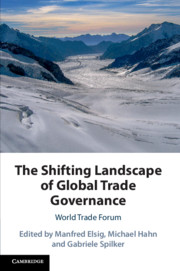Book contents
- The Shifting Landscape of Global Trade Governance
- The Shifting Landscape of Global Trade Governance
- Copyright page
- Contents
- Figures
- Tables
- Contributors
- Preface
- Abbreviations
- 1 Introduction
- Part I New and Old Challenges
- Part II Trade Policy and Trade-Related Concerns
- 7 Reconceiving Trade Agreements for Social Inclusion
- 8 Our Alarming Climate Crisis Demands Border Adjustments Now
- 9 The Multilateralization of PTAs’ Environmental Clauses
- 10 The Trend to More and Stricter Non-Trade Issues in Preferential Trade Agreements
- Part III Development Angles
- Part IV Diffusion across Economic Treaties
- Index
- References
9 - The Multilateralization of PTAs’ Environmental Clauses
Scenarios for the Future?
from Part II - Trade Policy and Trade-Related Concerns
Published online by Cambridge University Press: 05 August 2019
- The Shifting Landscape of Global Trade Governance
- The Shifting Landscape of Global Trade Governance
- Copyright page
- Contents
- Figures
- Tables
- Contributors
- Preface
- Abbreviations
- 1 Introduction
- Part I New and Old Challenges
- Part II Trade Policy and Trade-Related Concerns
- 7 Reconceiving Trade Agreements for Social Inclusion
- 8 Our Alarming Climate Crisis Demands Border Adjustments Now
- 9 The Multilateralization of PTAs’ Environmental Clauses
- 10 The Trend to More and Stricter Non-Trade Issues in Preferential Trade Agreements
- Part III Development Angles
- Part IV Diffusion across Economic Treaties
- Index
- References
Summary
Preferential trade agreements (PTAs) cover a much wider diversity of environmental clauses than World Trade Organization (WTO) agreements. Which PTA environmental clauses could be multilateralized and included in the WTO rulebook? This chapter compares five different scenarios for the potential multilateralization of PTA environmental clauses: (1) The “routine scenario” combines the most frequent clauses, (2) the “consensual scenario” includes the clauses accepted by a high number of WTO members, (3) the “trendy scenario” includes the most popular clauses in recent times, (4) “the power-game scenario” combines the clauses that are jointly supported by the United States and the European Union, and (5) the “appropriate scenario” is a compilation of the clauses typically included in large membership agreements. This chapter compares and contrasts the implications of each scenario and identifies their common ground. Although each scenario represents an ideal type unlikely to materialize, the comparison offers insights into how the multilateral trading system could be developed to improve the integration of environmental concerns.
- Type
- Chapter
- Information
- The Shifting Landscape of Global Trade GovernanceWorld Trade Forum, pp. 207 - 232Publisher: Cambridge University PressPrint publication year: 2019
References
- 2
- Cited by

